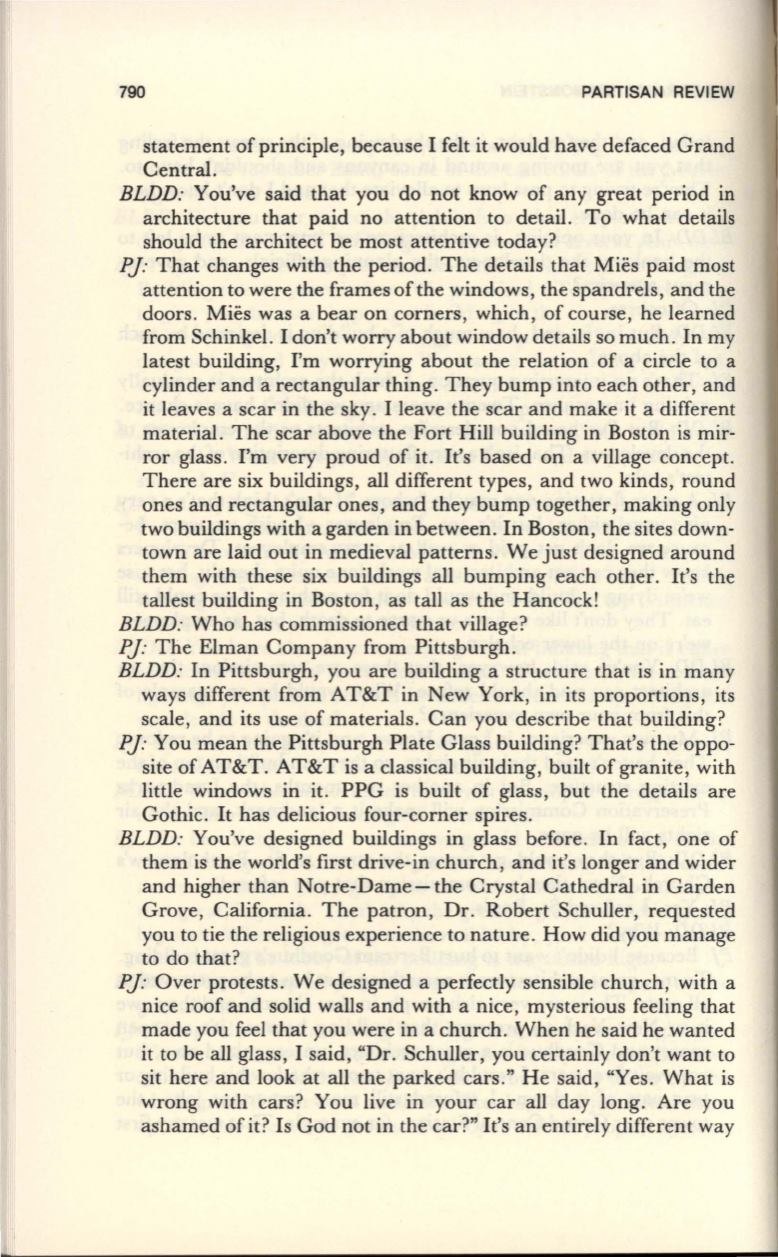
790
PARTISAN REVIEW
statement of principle, because I felt it would have defaced Grand
Central.
BLDD:
You've said that you do not know of any great period in
architecture that paid no attention to detail. To what details
should the architect be most attentive today?
PJ:
That changes with the period. The details that Mies paid most
attention to were the frames of the windows, the spandrels, and the
doors. Mies was a bear on corners, which, of course, he learned
from Schinkel. I don't worry about window details so much. In my
latest building, I'm worrying about the relation of a circle to a
cylinder and a rectangular thing. They bump into each other, and
it leaves a scar in the sky. I leave the scar and make it a different
material. The scar above the Fort Hill building in Boston is mir–
ror glass. I'm very proud of it. It's based on a village concept.
There are six buildings, all different types, and two kinds, round
ones and rectangular ones, and they bump together, making only
two buildings with a garden in between. In Boston, the sites down–
town are laid out in medieval patterns. We just designed around
them with these six buildings all bumping each other. It's the
tallest building in Boston, as tall as the Hancock!
BLDD:
Who has commissioned that village?
PJ:
The Elman Company from Pittsburgh.
BLDD:
In Pittsburgh, you are building a structure that is in many
ways different from AT&T in New York, in its proportions, its
scale, and its use of materials. Can you describe that
b~ilding?
PJ:
You mean the Pittsburgh Plate Glass building? That's the oppo–
site of AT&T. AT&T is a classical building, built of granite, with
little windows in it. PPG is built of glass, but the details are
Gothic.
It
has delicious four-corner spires.
BLDD:
You've designed buildings in glass before. In fact, one of
them is the world's first drive-in church, and it's longer and wider
and higher than Notre-Dame-the Crystal Cathedral in Garden
Grove, California. The patron, Dr. Robert Schuller, requested
you to tie the religious experience to nature. How did you manage
to do that?
PJ:
Over protests. We designed a perfectly sensible church, with a
nice roof and solid walls and with a nice, mysterious feeling that
made you feel that you were in a church. When he said he wanted
it to be all glass, I said, "Dr. Schuller, you certainly don't want to
sit here and look at all the parked cars." He said, "Yes. What is
wrong with cars? You live in your car all day long. Are you
ashamed of it? Is God not in the car?" It's an entirely different way


